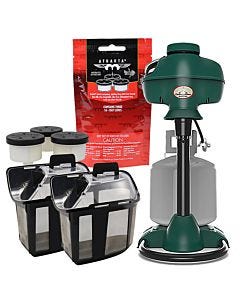FAQs - The Dangers of Mosquitos

Have questions?
Find immediate answers to commonly asked questions, such as do black flies transmit diseases, can you get encephalitis from black flies and more.
Black Fly Dangers | Midge Dangers | No-See-Um DangersFrequently Asked Questions about Black Fly Dangers
Q: Can Black Flies carry diseases?
A: Yes, they have been known to transmit diseases to humans and animals. In Africa, Central America and South America, Black Flies can transmit two diseases to humans: onchocerciasis, known as “river blindness,” and mansonellosis. In many countries of the world, Black Flies transmit diseases to animals including bovine onchocerciasis in cattle and horses, and leucocytozoonosis in wild birds.
Q: Can people die from Black Fly bites?
A: If a person has a severe allergic reaction to the bite and does not get prompt medical attention, death can result. Someone else could develop symptoms of “black fly fever” which include fever, headache, nausea and swelling of the lymph nodes.
In regions where onchocerciasis is found, Black Fly bite victims may develop blindness, though it rarely leads to death. In areas where mansonellosis is found, victims may not show any symptoms or in more severe cases, they may have stomach pain, joint pain, headaches, inflammation in the lungs, and swelling of the skin and lymph nodes. Death does not usually occur with either onchocerciasis or mansonellosis.
Q: Can you get encephalitis from Black Fly bites?
A: There is a possibility that they could also transmit encephalitis, but this has not been confirmed to date.
Q: Is there a cure for River Blindness?
A: Ivermectin is used to treat onchocerciasis, or River Blindness. It is important that people infected with the parasite have ready access to this medicine or blindness may result.
[back to top]Frequently Asked Questions about Midge Dangers
Q: Do Non-Biting Midges transmit diseases to people?
A: No, they don’t transmit diseases, but they sure can be annoying when they fly around people’s heads in swarms!
There have been some recent studies, however, which theorize that non-biting midges may play a role in the spread of cholera by carrying cholera bacteria to bodies of water including ponds, lakes and other water bodies. Further research is needed to confirm this.
Q: Do Non-Biting Midges transmit diseases to animals?
A: No, they are not known to be transmitters, or vectors, of disease to animals.
Q: Are these insects dangerous in any way to humans or animals?
A: They have been known to get in the ears, eyes, noses, and mouths of both people and animals. In some cases, the Non-Biting Midge can be responsible for allergic afflictions.
In addition, roads along lakes or rivers in some locations can be so fully swathed in non-biting midges that they become quite slick, occasionally leading to accidents.
[back to top]Diseases No-See-Ums Carry and Transmit
You may not always be able to see “no see ums,” but that doesn’t mean they can’t cause significant damage. Although only about one third the size of their mosquito cousins, these tiny pests are relentless when attempting to attach themselves to animal or human hosts to dine on their blood. But do No-See-Ums carry diseases, just like mosquitoes? The answer to this question is a resounding “yes”.
Q: Do No-See-Ums Transmit Diseases?
A: In addition to carrying diseases, no-see-ums can likewise transmit them through biting. But do no-see-ums transmit diseases to humans? While not all varieties of no-see-ums carry diseases, the bites of some types, particularly in tropical regions, can cause chronic conditions such as phlebotomus and leishmaniasis, which are difficult to cure. Filarial worms can also result from No-See-Um bites.
Q: Do No-See-Ums Carry Diseases That Can Result in Fatalities?
A: In general, the diseases carried by no-see-ums do not result in fatalities, although with some of the afflictions they cause, symptoms can reoccur over a period of many years. And what makes them so difficult to stop is that because of their small size, they can even fit through screens like the type commonly used in screen doors and windows. The use of an effective trap for no see ums is often the best way to thwart these pests. Note that the life of a Mosquito Magnet® trap may be impacted if consistently used in areas with dense populations of No-See-Ums. Proper trap maintenance is especially important in these areas.
Q: Do No-See-Ums carry West Nile Virus?
A: No, they do not carry West Nile Virus. Currently only mosquitoes are known to carry the disease.
Q: What diseases do No-See-Ums carry?
A: In some countries, particularly in tropical regions, these insects can be transmitters of parasites and diseases such as filarial worms in humans and bluetongue virus in livestock.
Bluetongue results in more than $120 million dollars in financial loss in the livestock industry each year.
No-See-Ums can also transmit Hemorrhagic Disease to white-tailed deer.
[back to top] Protect your family, pets and guests from annoying mosquitoes with a Mosquito Magnet® trap - the leading long-term, scientifically-proven mosquito control solution
Protect your family, pets and guests from annoying mosquitoes with a Mosquito Magnet® trap - the leading long-term, scientifically-proven mosquito control solution




